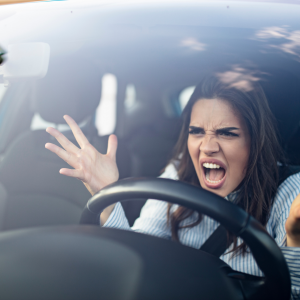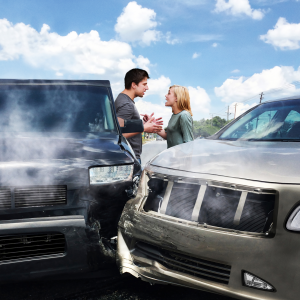What is Road Rage?
Is Road Rage Dangerous?
Emotions get the best of all of us at times, but when driving on the road, we have a responsibility to use good judgement, composure, and respect amongst fellow drivers and pedestrians. It is tempting to get angry or upset when someone clearly cuts you off or abruptly changes lanes without signaling, and that same anger can tempt you to start raging at someone and practicing reckless driving. Giving into your emotions in the heat of the moment can intensify the danger of an already precarious situation; often termed as “road rage,” aggressive retaliation on the road can trigger a series of dangerous, and even deadly, consequences. With all of this in mind, there are safe practices to manage your frustration and to be on the alert for when sharing the road with aggressive drivers.
If you were involved in a car accident with a driver suffering from road rage, you have the right to file a claim against that driver. A car accident lawyer from Munley Law Personal Injury Attorneys can help. Contact our law firm today to learn your legal options and to schedule a free consultation.
What is Road Rage?
 With approximately 205 million drivers in the United States, it’s imperative that we strive to be considerate, responsible drivers. According to the National Highway Traffic Safety Administration (NHTSA), road rage is defined as, “The operation of a motor vehicle in a manner that endangers or is likely to endanger persons or property.” An important distinction is that aggressive driving is a traffic violation, while road rage, aside from the yelling and gesticulating, is a criminal offense.”
With approximately 205 million drivers in the United States, it’s imperative that we strive to be considerate, responsible drivers. According to the National Highway Traffic Safety Administration (NHTSA), road rage is defined as, “The operation of a motor vehicle in a manner that endangers or is likely to endanger persons or property.” An important distinction is that aggressive driving is a traffic violation, while road rage, aside from the yelling and gesticulating, is a criminal offense.”
What are the most common road rage offenses?
- Angry, rude, and/or obscene gestures
- Speeding
- Sporadic headlight use
- Chasing other vehicles in rage
- Following improperly
- Making an improper turn
- Using lanes inappropriately; changing lanes abruptly; erratic lane changing
- Getting out of your car to threaten another driver
- Physically confronting another driver, passenger, cyclist, or another individual
- Excessive honking
- Bumping or ramming into another vehicle on purpose
- Blocking another car
- Erratic braking and bullying
- Tailgating another vehicle
- Physical violence and confrontation
- Pulling a gun on another driver
How Often Does Road Rage Occur?
New research from The AAA Foundation for Traffic Safety (AAAFTS) conducted new studies showing that unsafe driving behaviors increased 8 percent between 2020 and 2021. The survey also found that 23 percent of drivers surveyed admitted to aggressive driving incidents by switching lanes quickly or tailgating very close behind another car. Unfortunately, curbing road rage incidents has not shown a downward trend.
The AAAFTS study also found:
- About 78 percent of drivers in the U.S. reported expressing aggression or road rage in the past year.
- About 3 percent, or 5.7 million drivers, admitted they had bumped another vehicle on purpose due to anger.
- About 4 percent (7.6 million drivers) reported that they had gotten out of the car to confront another driver.
- Men were three times more likely than women to purposely hit another car out of road rage or to get out of their cars to confront another driver.
- Drivers in the Northeast United States were more likely than other drivers in the country to make an angry gesture from behind the wheel.
What Are the Common Causes of Road Rage?
 Environmental circumstances and scenarios can have a significant hand in the increase in aggressive driving incidents. Crowded highways, holiday traffic, and road construction delays all may be factors in what can trigger frustration and road rage. Emotional and personal stress, drinking, drug use and fatigue are other contributions, as well. There are many common behaviors that can lead to aggressive driving, and there are also many ways to avoid them:
Environmental circumstances and scenarios can have a significant hand in the increase in aggressive driving incidents. Crowded highways, holiday traffic, and road construction delays all may be factors in what can trigger frustration and road rage. Emotional and personal stress, drinking, drug use and fatigue are other contributions, as well. There are many common behaviors that can lead to aggressive driving, and there are also many ways to avoid them:
- Lane blocking. Do not block the passing lane — this is a peeve for so many drivers, and a sure way to turn the road rage switch on. If other drivers wants to drive faster, do not drive in the far left lane, or yield to the right for any vehicle that is going faster than you and that aims to pass you.
- Tailgating. To ensure that you do not fall guilty of this, keep a safe distance from the vehicle in front of you. If you fall victim of being tailgated, create more space between you and the vehicle in front of you.
- Use your signals. Anticipate changes and use your signals to inform your fellow drivers that you are changing lanes, and avoid changing lanes too close to the other moving vehicles. Once you have completed your lane change, turn your signal off.
- Minimize gesturing. If you have to gesture to a fellow driver, make sure you gesture in a way that will not be interpreted as hostile, obscene, or in a way that can be misinterpreted.
- Minimize use of the horn. Do not use your horn to say “hello” to a pedestrian. The driver in front of you might think you are honking at them to move.
- Not turning when you are permitted to. Unless signs indicate otherwise, right turns are allowed after a complete stop at a red light: go! If you wait for the green light, fellow drivers can easily get frustrated.
- Parking in multiple spaces. Do not take more than one parking space and do not park in the disabled parking space if you do not have a disabled parking placard or plates.
- Use your headlights appropriately and considerately. If you use your high-beam headlights, dim your lights for oncoming traffic and when approaching a vehicle from behind; do not retaliate to oncoming high beams with your own.
- Failing to be gracious and to yield with merges. When traffic permits, make room to allow vehicles to merge into your lane.
- Failure to be in good condition to drive. Make sure that when you make the decision to get behind the wheel and drive, you have had adequate rest, you have not been drinking excessively, that your judgement is not impaired from taking medication, and that you are not driving when under the influence of drugs.
What is the Psychology of an Aggressive Driver?
The American Psychological Association (APA) has shed some light on what makes some individuals more prone to exhibiting acts of road rage than others; our coping mechanisms to adversity and managing our anger are certainly contributions. Environmental factors are key in bringing about the perfect storm — crowded roads, long drives, and expended mileage make drivers more likely to experience anger. Life stress may be brought to the driver seat and mount in displaced anger, and blaming others. The APA cites psychologist Jerry Deffenbacher’s study, exposing five key differences between high-anger drivers and low-anger drivers:
- A driver’s inclination to engage in hostile, aggressive thinking; revenge or insult pursuits, and likeliness to physicalize their anger.
- A driver’s inclination to engage in more risk-taking on the road; excessive speeding, rapid lane changes, tailgating, and running red lights.
- A driver’s driving history of frequent close accidents and ticketed speeding violations.
- A driver’s susceptibility to be more emotionally volatile due to life stresses at work or home; the driver feels anger, anxiety, and impulsiveness more readily.
- A driver’s pre-existing state of heightened anger can facilitate agitation quicker, promote aggressive driving, and a likeliness to act out their anger; their anger manifests in all of their actions throughout the course of their day.
Deffenbacher concluded that with cognitive and relaxation training, high-anger individuals can recognize, manage, and implement learned coping skills. By implementing relaxation techniques, cognitive restructuring, and reframing of negative events, studies reported cases proven to show that the frequency and intensity of a driver’s anger can be curbed and even sustained after a year follow-up (Sansone, R.A., & Sansone, L.A. (2010), APA).
How Can You Avoid Aggressive Road Rage Incidents?
 When you are driving in your car on the road, you are left to make assessments, choices, and adjustments by discriminating the movements of the vehicles that you share the road with. We are not at liberty to know if someone is having a bad day or enduring a crisis, or simply an angry person; regardless of the case, it is in your best interest to always drive defensively. Should you share the road with an aggressive driver, the best thing you can do is acknowledge the circumstance, minimize your positioning in relationship to the aggressive driver, and go with the flow of traffic. Do not be fazed — this is the time to take any road bullying on the chin, and to call emergency services if you feel in danger.
When you are driving in your car on the road, you are left to make assessments, choices, and adjustments by discriminating the movements of the vehicles that you share the road with. We are not at liberty to know if someone is having a bad day or enduring a crisis, or simply an angry person; regardless of the case, it is in your best interest to always drive defensively. Should you share the road with an aggressive driver, the best thing you can do is acknowledge the circumstance, minimize your positioning in relationship to the aggressive driver, and go with the flow of traffic. Do not be fazed — this is the time to take any road bullying on the chin, and to call emergency services if you feel in danger.
- Don’t participate with an aggressive driver. Roll with it. Engaging with someone who is experiencing road rage can heighten the circumstances. Keep a distance, if possible, and avoid eye contact. Stay out of the way and allow them to pass you; refrain from responding to road bullying in anyway. If you feel in danger, contact the police.
- Admit fault. To diffuse potential road rage, casually wave or mouth “sorry” to the other driver. It does not hurt to be proactive, and a simple gesture can negate a potential flare-up of road rage.
- Practice good driving etiquette. Stay in your lane appropriately, signal when needed, anticipate lane changes and inform your fellow drivers accordingly, use the fast lane appropriately, do not tailgate, do not speed; respect the road and you fellow drivers.
- Do not lean on that horn repeatedly. Reserve to use your horn when it is essential— an emergency, or to alert another driver when absolutely necessary. When you do use your horn, use it lightly. Another way to alert a fellow driver, when suitable, is to blink your lights, should that suffice (depending on the situation).
- Contact a road rage hotline. Reporting aggressive driving to a hotline or to authorities is always a good choice, as you are looking out for yourself and your fellow drivers.
- Relax. If you are experiencing road rage and agitation yourself, try to focus on breathing exercises – counting aloud, calming music, and keep your focus on the road.
How Not to Become the Aggressive Driver
Firstly, you want to be able to recognize and avoid the behaviors in yourself that may prompt aggressive driving. This self-acknowledgement and awareness will allow you to take the second step, and to avoid other drivers who engage in these behaviors. Some guides to steer yo in the clear are:
- Allow sufficient time for you to reach your destination
- Do not change lanes abruptly; do not “cutoff” fellow drivers
- Do not bully others on the road; do not tailgate
- Do not physicalize your anger by gesturing to other drivers
- Only use your horn for emergencies
- Use the proper lanes accordingly; do not drive fast in the slow lane, and do not drive slow in the fast lane
- Let aggressive drivers on the road pass you; do not engage
What Are the Consequences of Road Rage Incidents?
According to the NHTSA, one-third of car accidents are linked to aggressive driving behaviors. A road rage incident can cause property damages, physical damages, mental damages, emotional anguish, and even death. A negligent driver who causes a car crash due to road rage may be liable for victim’s medical bills and other financial losses related to the accident. A personal injury attorney may use the scene’s physical evidence, witness statements, and all other applicable evidence to establish that a car accident was caused due to negligence. Although aggressive driving behaviors often spark road rage incidents, the law considers aggressive driving a misdemeanor traffic offense, while road rage behaviors are considered crimes penalized by large fines, loss of license, loss of insurance, and possible jail time.
If you have been in a car crash with an aggressive driver, contact the personal injury lawyers at Munley Law Personal Injury Attorneys for a free consultation. There is no fee unless we win.
Posted in Car Accidents.









